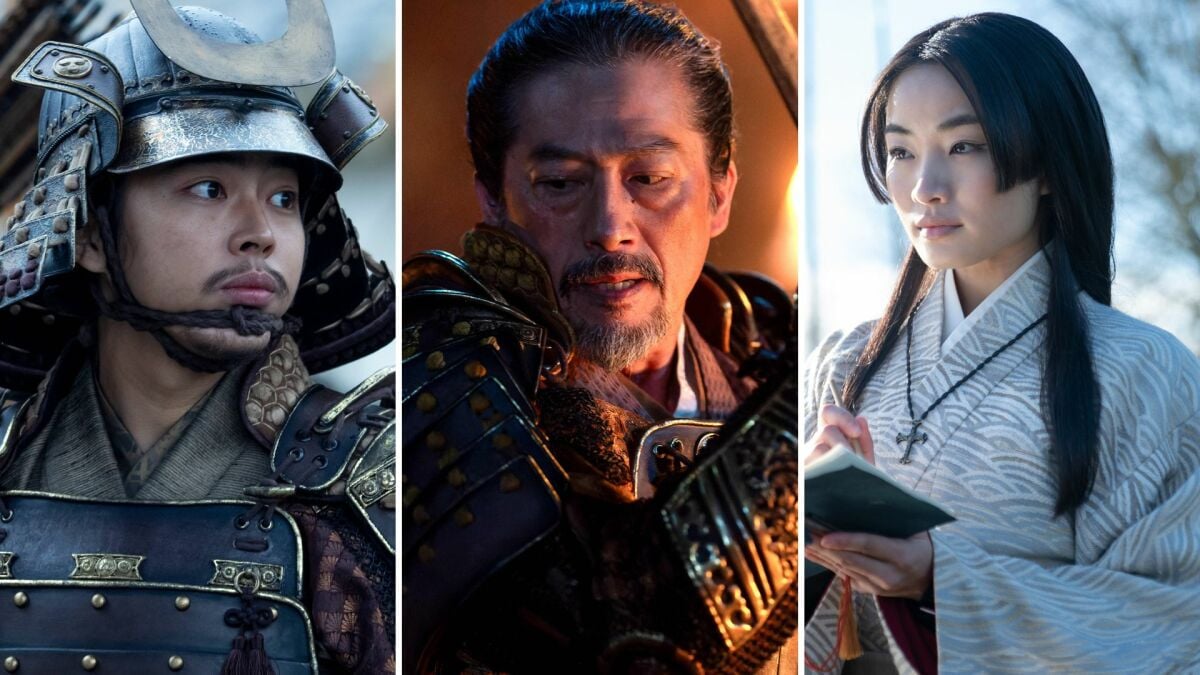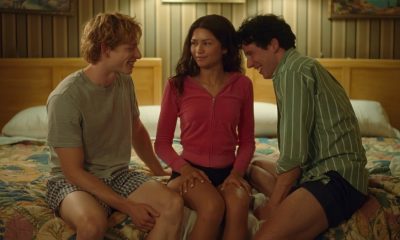Entertainment
‘Shōgun’ is a master class in period costuming

It didn’t just take a village to costume FX’s Shōgun — it took an army.
The Shōgun costume department spanned several countries, including the show’s main shooting location in Vancouver. There, a team of around 125 people, headed by costume designer Carlos Rosario, worked with their international collaborators — a team Rosario estimates falls between 250 and 300 people — to produce the over 2,300 costumes needed to bring Shōgun to life.
The goal? To create a range of costumes that would read as authentic to 1600 Japan, when Shōgun is set, and that would also express character in subtle, meaningful ways. In an interview with Mashable, Rosario delved into the collaborative research process behind Shōgun‘s costumes, the ways in which clothing on the show reveals status, and how costumes showcase the evolution of characters like Japanese translator and noblewoman Toda Mariko (Anna Sawai) and English pilot John Blackthorne (Cosmo Jarvis).
Shōgun‘s costumes strive for period authenticity through collaboration.

Hiroyuki Sanada in “Shōgun.”
Credit: Katie Yu / FX
Right from pre-production, one of the most important aspects for every design element of Shōgun was ensuring authenticity. To achieve that in the series’ costuming, Rosario collaborated with historian Frederik Cryns, professor of Japanese history at the International Research Center for Japanese Studies in Kyoto. Cryns provided a historical foundation for Rosario and his team, and also directed him to paintings from the Sengoku period for inspiration directly rooted in history.
Rosario also worked with Shōgun star and producer Hiroyuki Sanada, who advocated for cultural faithfulness and specificity across the board. (At a Television Critics Association panel, Sanada declared the show a “dream East-meets-West” collaboration.) Sanada brought his longtime dresser to Vancouver to teach the costuming team how to properly dress actors in Japanese period clothing. Experts in kimono dressing also provided consultation on how to perfect the looks of Shōgun‘s women.
“By the second episode, everybody was a professional [at dressing the Shōgun actors] because they had to do that so many times every day, for so many people,” Rosario told Mashable. “It was a group effort.”
For the actual costume creation, the Shōgun team rented about 1,300 pieces and bought modern-day kimonos that they altered to give the shape of a kosode. “The kosode is the ancestor to the kimono,” Rosario explained.
By the end of filming, Shōgun‘s costume pieces filled a massive warehouse in Vancouver — something Rosario could never have dreamed of at the start of the process. “When I saw the warehouse in the beginning, I thought, ‘Oh my God, this is way too big. There’s no way we’re going to be able to fill this space,'” Rosario said. “Then, I think by the second episode, it was all filled. We had to create racks on top of each other.”
Every detail of Shōgun‘s costumes means something — especially when it comes to status.

Cosmo Jarvis and Anna Sawai in “Shōgun.”
Credit: Katie Yu / FX
Rosario worked to incorporate every tidbit of his research into Shōgun. For example, he learned that only lords and ladies could wear tabi — split-toe socks — indoors. As a result, you’ll notice that less influential characters are barefoot in the scenes taking place in Osaka Castle.
There’s even a hierarchy of status when it comes to the material of the tabi socks. Members of the Council of Regents wear deerskin tabi. (“Hiroyuki Sanada said he’d never seen tabi as beautiful,” Rosario said.) But the highest-ranking characters, such as Lady Ochiba (Fumi Nikaido), mother of the heir, wear tabi made of cotton. Why? “Cotton was very rare at the moment, and very expensive,” said Rosario.
Fabric as a status symbol factored into another key element of Shōgun‘s costuming: layering. “The more layers you have, obviously the more fabric you need to use, and the more expensive it gets,” Rosario said. This is why villagers in Ajiro wear one layer of clothing, while higher-ranking characters wear several.
Layering is especially important when it comes to the women of Shōgun. Rosario explained that Lady Ochiba, being the highest-ranking woman, would usually wear five or six layers, while Mariko would usually wear two or three. Even though the lowest layers of clothing weren’t always visible, Shōgun‘s costuming team worked to keep them periodically accurate. The weight of the layers proved influential to the actors’ performances, effecting their physicality and speech.
Meanwhile, Rosario relished working with so many different layers, even if some would never be seen in their entirety. “It’s how architectural it is, and how you could play with all these different tones that could work together,” he said. “It’s a beautiful moment of styling, when you have to just work with the colors.”
On the less flashy side, pay attention to the men’s hakama — wide-legged, almost skirt-like pants — for more indicators of status. More pleats means more fabric, so Ajiro’s villagers pants tend to only have one pleat, while people like Toranaga have far more.
“We created our own language with the clothing,” Rosario said of these revealing choices.
Shōgun‘s costumes also reveal character.

Anna Sawai in “Shōgun.”
Credit: Katie Yu / Fx
In addition to emphasizing status, Shōgun‘s costumes are also hints at a character’s mental state or their place in Shōgun‘s broader narrative. In an interview with Harper’s Bazaar, Rosario spoke to how Mariko’s costumes at first depict lifeless scenes covered in snow as a reflection of her cold outlook on life. As the season continues and she embraces her role as translator for Blackthorne, her internal world comes alive. To reflect that change, Rosario incorporated flowers, brighter colors, and bolder patterns into Mariko’s looks.
Blackthorne’s costumes undergo an evolution of their own, Rosario told Mashable. We first meet him in his British clothing, including britches and a blouse. But once he’s taken in by Toranaga, he’s given a kosode. “To me, symbolically, it means he’s letting go of his identity,” said Rosario.
The more time Blackthorne spends with Toranaga, the more Japanese pieces Rosario added to his overall costume, such as hakama pants or sodenashi (sleeveless work jackets or vests). “All that was a way for the audience to see that slowly, he’s been immersing himself into Japanese culture,” Rosario said. “Or it’s almost like they are imposing on him the fact that, if you’re going to be here, you need to look Japanese.”
Still, Blackthorne’s color palette remains fairly neutral and plain — a contrast from his more “flamboyant” looks in the 1980 miniseries. “He’s one of the lead male characters, but in that world, he’s a foreigner. He’s powerless,” said Rosario. “I had wanted to keep him very basic, so it would contrast with the opulence and the luxurious fabric of all the other characters around him.”
One of the most luxurious characters of all? Toranaga himself. Toranaga’s looks don’t go through a season-long evolution in the same way that Mariko or Blackthorne’s do. Instead, the goal for his costumes was adapting to Toranaga’s changing needs in a variety of circumstances, whether he’s politicking in Osaka, going hunting, or traveling to Ajiro.
“This wasn’t like a show where you create a wardrobe for each character and go back to the closet for every episode and pull something,” Rosario said of working on Toranaga’s looks. “We continuously needed to actually design everything until the last episode, so there was no relaxation.”
Toranaga’s power asserts itself through his clothes — not just the copious amount he has, but also their use of more luxurious fabrics and colors that denote prosperity, like golds and coppers. “I had wanted to [show] mostly his wealth, his abundance, and his authority over everybody else,” said Rosario. “If you notice, he’s the only character who actually changes costumes in pretty much every scene in the first episode. Every single scene, he’s wearing a different outfit. He’s the only one. That was my way of saying he’s above everybody else.”
Between the grand scope of Shōgun and the intense amount of research, manpower, and physical endurance that went into its costuming, Rosario considers his work on the show to be his greatest yet. “I just feel like this is my legacy,” he said. “This is as good as it gets. Who gets to design something like this in a lifetime?”
Shōgun is now streaming on Hulu.
-

 Business7 days ago
Business7 days agoThis camera trades pictures for AI poetry
-

 Business6 days ago
Business6 days agoTikTok Shop expands its secondhand luxury fashion offering to the UK
-

 Business7 days ago
Business7 days agoBoston Dynamics unveils a new robot, controversy over MKBHD, and layoffs at Tesla
-

 Business5 days ago
Business5 days agoMood.camera is an iOS app that feels like using a retro analog camera
-

 Business5 days ago
Business5 days agoUnitedHealth says Change hackers stole health data on ‘substantial proportion of people in America’
-

 Business4 days ago
Business4 days agoTesla’s new growth plan is centered around mysterious cheaper models
-

 Entertainment5 days ago
Entertainment5 days agoFurious Watcher fans are blasting it as ‘greedy’ over paid subscription service
-

 Business4 days ago
Business4 days agoTwo widow founders launch DayNew, a social platform for people dealing with grief and trauma




























